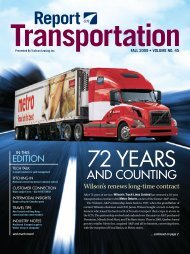Fall 2004 - Trailcon
Fall 2004 - Trailcon
Fall 2004 - Trailcon
Create successful ePaper yourself
Turn your PDF publications into a flip-book with our unique Google optimized e-Paper software.
Trucking industry prepares toroll out food-safety programAs shippers of food productsbecome more vigilant aboutfood-safety standards throughoutthe supply chain, the truckingindustry is responding.The Canadian Trucking Alliance(CTA) has developed a foodsafetyprogram for carriersbased on the Hazard Analysisand Critical Control Point, betterknown as HACCP. This is aninternationally recognized systemdesigned to minimize therisk of food-safety hazards.Pillsbury and NationalAeronautics and SpaceAdministration (NASA) firstused HACCP in the 1960s toensure that astronauts had asafe food supply while in space.Now its principles can beapplied to all segments of thefood chain.CTA’s initiative got under waynearly two years ago, explainsRon Lennox, Vice-President,Regulatory Affairs. “TheCanadian Food InspectionAgency [CFIA] was encouragingindustry sectors to developHACCP-based food-safety programs,”he says. “We looked atit then, and we were starting toget calls already from carrierswho were saying shippers offood products were becomingmore and more interested incarriers who had HACCP inplace. There wasn’t a programout there, so we decided todevelop one of our own.”Throughout 2003, working witha consultant and some of thenational associations in the foodindustry, CTA put together aHACCP-based trucking foodsafetyprogram. It was approvedby CFIA, but had to be pilotedbefore it could be rolled out tothe industry.“About the time that we finisheddeveloping the program,Agriculture and Agri-FoodCanada put in place a new program,the Food Safety andQuality program,” says Lennox.“With funding from that program,CTA is now piloting thattrucking food-safety program.We have 10 carriers from acrossthe country who are actuallyusing the program and thefood-specific modules that wedeveloped, and integrating theminto their operations right now.”Lennox says the program is verydetailed. Besides addressingmajor issues such as temperatures,health, and hygiene, itcovers “everything right downto washing the truck and whatchemicals to use to deal withwhat pathogens,” he says.Once the pilot has been completedand any amendmentsapproved by Agriculture andAgri-Food Canada, the programwill be rolled out to the industry,possibly by the end of thisyear.StatsCan launches online databaseStatistics Canada recentlylaunched the “North AmericanTransportation Statistics” database,an online source for informationon transportation activity.It covers 12 specific areas ofinterest, including freight transportationand safety.For example, in 2000, transportationand transportationrelatedindustries accounted for15% of the gross domesticproduct in Canada, comparedwith 11% in the U.S. About 15.9million people, or 9% of theemployed labour force in NorthAmerica, worked in transportationand related industries.Over 259 million road motorvehicles traveled on more than8 million kilometers of road inNorth America that same year.Canada’s motor vehicle fatalityrate was 1.6 fatalities per10,000 road motor vehicles,compared with a rate of 1.9 inthe U.S. and 7.0 in Mexico.FALL <strong>2004</strong> - VOLUME NO. 3111






